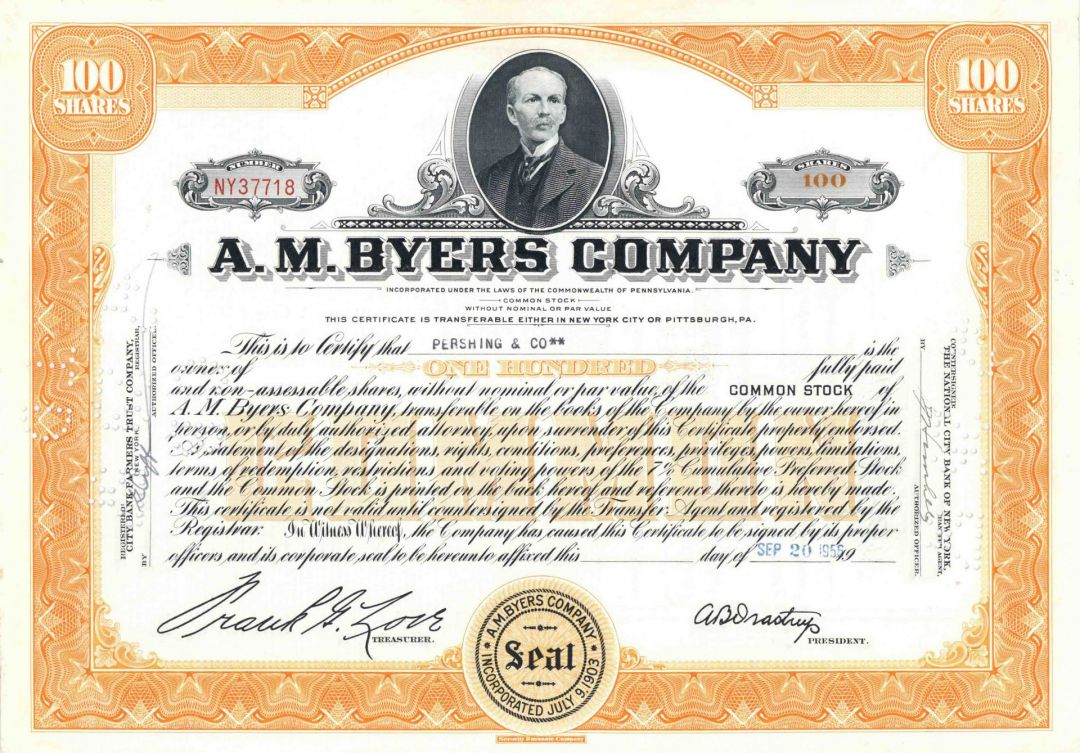A. M. Byers Co. - Stock Certificate - Great History - Alexander McBurney Byers
Inv# GS1001 StockGeneral Stock. Portrait vignette of Mr. A.M. Byers. Scarce!!! Available in Orange, Brown or Blue. Please specify color.
The A.M. Byers Company, America's oldest and largest producer of wrought iron products, had been a member of the industrial community of Ambridge since 1930 and until 1969. It was on October 8, 1930 when this great plant, located on Route 65 along the Ohio River and Old Route 88 known as Duss Avenue in adjacent Harmony Township, was dedicated; and its opening marked the beginning of a new era in the manufacture of this time-proven metal.
Designed for what was known as the Byers Process for manufacturing wrought iron, this new production method permitted for the first time, quantity production, quality control of operation, and assurance of uniformity in the product that was undreamed of by the old iron manufacturers.
The raw materials from which wrought iron is made by this method consisted of pig iron, iron oxide, and silica slag. In this process, pig iron was melted in cupolas and purified in Bessemer converters to the highly refined state required for the base metal in quality wrought iron. The base metal was then processed in molten iron silicate slag resulting in wrought iron of uniform and high quality.
The work force of the A.M. Byers Company was made up of men of ten or more ethnic groups; such as the Slavs (consisting of Slavish, Hungarian, Poles, Ukranians, Russians, Croations, Serbians), Germans, Italians, and Scots. The workers were virtually a melting pot of first and second generation Americans of the early immigrants.
The 1929 "Depression" fell upon Ambridge in October of that year. So when A.M. Byers opened one year later in 1930, there was a large influx of local unemployed men-plus the addition o so called "Out-of-Towners" from the coal fields of Western Pennsylvania and West Virginia as well as other steel mills of Beaver County and Pittsburgh. The workforce grew so as to-fill the accumulated back orders and replacement demand for this specialized metal.
The Plant's Bessemer converter furnaces were located about one-hundred and fifty feet inside the chain link fence bordering Route 88 (Duss Avenue). The memorable scene of blowing furnace mouths, spewing showers of sparks, and volcanic columns of varying colored smoke high into the air was an awe inspiring spectacle to passing motorists, especially to out of state tourists.
This production show would repeat approximately each half hour at this place along the former National "Lincoln Highway," now called Duss Avenue. At times strong winds and breezes would carry the sparks and fallout out onto the highway causing some paint searing spots for those uninformed motorists who stopped and lingered.
By 1936 orders for wrought iron dropped off reflecting the uncertain economic market that the whole world was facing. The A.M. Byers Company then staggered their production days to intervals of two and three weeks off and on.
I have lived in the nearby village of "Byersdale" (named after the plant) since 1937 and still live there in 1981. After the 1935 era, I do not recall that Byers ever changed that sporadic work schedule for four or five years. I drove by the Byers Plant site two to four times each day.
After 1940, the production bloomed increasingly to full three shifts per day because of defense orders and World War 11. They produced seven days per week until the fall of 1945-the end of the war.
The A.M. Byers Company owned extensive vacant acreage east and north of its plant. The company leased the north plot to the U.S. Government who then placed 450 trailer homes on wheels on this site to accommodate shortages of living space for the area's defense workers. The quarters were equipped with running water, electric power, butane tanks and underground sewage piping.
Most of these defense workers (migrants) were brought in from Mexico, Portugal, Cuba and American Appalachia. Immediately after the end of the war, these workers were laid off. They returned to their homelands loaded with American War Bonds and cash. It can well be assumed that a low, unknown, percentage stayed on in this area. They scattered here and there blending in to various communities.
A.M. Byers Company adjusted to a new set of post-war economic conditions, and reverted back to sporadic production until closing in 1969. From https://www.bcpahistory.org/beavercounty/BeaverCountyTopical/Industry/AMByersCo/AMByersMSP84.html
Also Read more at https://www.findagrave.com/memorial/122208445/alexander-mcburney-byers
A stock certificate is issued by businesses, usually companies. A stock is part of the permanent finance of a business. Normally, they are never repaid, and the investor can recover his/her money only by selling to another investor. Most stocks, or also called shares, earn dividends, at the business's discretion, depending on how well it has traded. A stockholder or shareholder is a part-owner of the business that issued the stock certificates.










Ebay ID: labarre_galleries